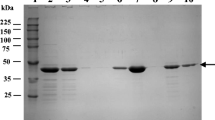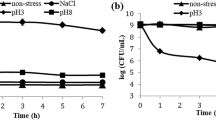Abstract
In this work, we studied the role of surface layer (S-layer) proteins in the adaptation of Lactobacillus acidophilus ATCC 4356 to the osmotic stress generated by high salt. The amounts of the predominant and the auxiliary S-layer proteins SlpA and SlpX were strongly influenced by the growth phase and high-salt conditions (0.6 M NaCl). Changes in gene expression were also observed as the mRNAs of the slpA and slpX genes increased related to the growth phase and presence of high salt. A growth stage-dependent modification on the S-layer protein profile in response to NaCl was observed: while in control conditions, the auxiliary SlpX protein represented less than 10 % of the total S-layer protein, in high-salt conditions, it increased to almost 40 % in the stationary phase. The increase in S-layer protein synthesis in the stress condition could be a consequence of or a way to counteract the fragility of the cell wall, since a decrease in the cell wall thickness and envelope components (peptidoglycan layer and lipoteichoic acid content) was observed in L. acidophilus when compared to a non-S-layer-producing species such as Lactobacillus casei. Also, the stationary phase and growth in high-salt medium resulted in increased release of S-layer proteins to the supernatant medium. Overall, these findings suggest that pre-growth in high-salt conditions would result in an advantage for the probiotic nature of L. acidophilus ATCC 4356 as the increased amount and release of the S-layer might be appropriate for its antimicrobial capacity.




Similar content being viewed by others
References
Ashida N, Yanagihara S, Shinoda T, Yamamoto N (2011) Characterization of adhesive molecule with affinity to Caco-2 cells in Lactobacillus acidophilus by proteome analysis. J Biosci Bioeng 112:333–337. doi:10.1016/j.jbiosc.2011.06.001
Avall-Jääskeläinen S, Palva A (2005) Lactobacillus surface layers and their applications. FEMS Microbiol Rev 29:511–529
Avall-Jääskeläinen S, Hynönen U, Ilk N, Pum D, Sleytr UB, Palva A (2008) Identification and characterization of domains responsible for self-assembly and cell wall binding of the surface layer protein of Lactobacillus brevis ATCC 8287. BMC Microbiol 8:165. doi:10.1186/1471-2180-8-165
Boot HJ, Kolen CP, Pouwels PH (1996) Interchange of the active and silent S-layer protein genes of Lactobacillus acidophilus by inversion of the chromosomal slp segment. Mol Microbiol 21:799–809
Buck BL, Altermann E, Svingerund T, Klaenhammer TR (2005) Functional analysis of putative adhesion factors in Lactobacillus acidophilus NCFM. Appl Environ Microbiol 71:8344–8351
Capozzi V, Arena MP, Crisetti E, Spano G, Fiocco D (2011) The hsp 16 gene of the probiotic Lactobacillus acidophilus is differently regulated by salt, high temperature and acidic stresses, as revealed by reverse transcription quantitative PCR (qRT-PCR) analysis. Int J Mol Sci 12:5390–5405. doi:10.3390/ijms12085390
Crow VL, Coolbear T, Gopal PK, Martley FG, McKay LL, Riepe H (1995) The role of autolysis of lactic acid bacteria in the ripening of cheese. Int Dairy J 5:855–875
Edman P (1949) A method for the determination of amino acid sequence in peptides. Arch Biochem Biophys 22:475–480
Fouet A (2009) The surface of Bacillus anthracis. Mol Asp Med 30:374–385. doi:10.1016/j.mam.2009.07.001
Fox PF, Wallace JM, Morgan S, Lynch CM, Niland EJ, Tobin J (1996) Acceleration of cheese ripening. Antonie Van Leeuwenhoek 70:271–297
Frece J, Kos B, Svetec IK, Zgaga Z, Mrsa V, Suskovic J (2005) Importance of S-layer proteins in probiotic activity of Lactobacillus acidophilus M92. J Microbiol Res 1:65–78
Gerbino E, Carasi P, Mobili P, Serradell MA, Gómez-Zavaglia A (2015) Role of S-layer proteins in bacteria. World J Microbiol Biotechnol 31:1877–1887. doi:10.1007/s11274-015-1952-9
Goh YJ, Azcárate-Peril MA, O’Flaherty S, Durmaz E, Valence F, Jardin J, Lortal S, Klaenhammer TR (2009) Development and application of a upp-based counterselective gene replacement system for the study of the S-layer protein SlpX of Lactobacillus acidophilus NCFM. Appl Environ Microbiol 75:3093–3105. doi:10.1128/AEM.02502-08
Hynönen U, Palva A (2013) Lactobacillus surface layer proteins: structure, function and applications. Appl Microbiol Biotechnol 97:5225–5243. doi:10.1007/s00253-013-4962-2
Hynönen U, Kant R, Lähteinen T, Pietilä TE, Beganović J, Smidt H, Uroić K, Avall-Jääskeläinen S, Palva A (2014) Functional characterization of probiotic surface layer protein-carrying Lactobacillus amylovorus strains. BMC Microbiol 14:199. doi:10.1186/1471-2180-14-199
Jakava-Viljanen M, Avall-Jääskeläinen S, Messner P, Sleytr UB, Palva A (2002) Isolation of three new surface layer protein genes (slp) from Lactobacillus brevis ATCC 14869 and characterization of the change in their expression under aerated and anaerobic conditions. J Bacteriol 184:6786–6795
Johnson BR, Hymes J, Sanozky-Dawes R, Henriksen ED, Barrangou R, Klaenhammer TR (2015) Conserved S-layer-associated proteins revealed by exoproteomic survey of S-layer-forming lactobacilli. Appl Environ Microbiol 82:134–145. doi:10.1128/AEM.01968-15
Kaji R, Kiyoshima-Shibata J, Nagaoka M, Nanno M, Shida K (2010) Bacterial teichoic acids reverse predominant IL-12 production induced by certain Lactobacillus strains into predominant IL-10 production via TLR2-dependent ERK activation in macrophages. J Immunol 184:3505–3513. doi:10.4049/jimmunol.0901569
Kets E, Teunissen P, de Bont J (1996) Effect of compatible solutes on survival of lactic acid bacteria subjected to drying. Appl Environ Microbiol 62:259–261
Khaleghi M, Kermanshahi RK (2012) Effect of environmental stresses on S-layer production in Lactobacillus acidophilus ATCC 4356. In: Petre M (ed) Advances in applied biotechnology, chapter 11. InTech, Rijeka. doi:10.5772/28334
Khaleghi M, Kasra Kermanshahi R, Yaghoobi MM, Zarkesh-Esfahani SH, Baghizadeh A (2010) Assessment of bile salt effects on S-layer production, slp gene expression and, some physicochemical properties of Lactobacillus acidophilus ATCC 4356. J Microbiol Biotechnol 20:749–756
Kim H, Jung BJ, Jeong J, Chun H, Chung DK (2014) Lipoteichoic acid from Lactobacillus plantarum inhibits the expression of platelet-activating factor receptor induced by Staphylococcus aureus lipoteichoic acid or Escherichia coli lipopolysaccharide in human monocyte-like cells. J Microbiol Biotechnol 24:1051–1058
Klaenhammer TR, Barrangou R, Buck BL, Azcarate-Peril MA, Altermann E (2005) Genomic features of lactic acid bacteria effecting bioprocessing and health. FEMS Microbiol Rev 29:393–409
Koch S, Oberson G, Eugster-Meier E, Meile L, Lacroix C (2007) Osmotic stress induced by salt increases cell yield, autolytic activity, and survival of lyophilization of Lactobacillus delbrueckii subsp. lactis. Int J Food Microbiol 117:36–42
Kos B, Suskovic J, Vukovic S, Simpraga M, Frece J, Matosic S (2003) Adhesion and aggregation ability of probiotic strain Lactobacillus acidophilus M92. J Appl Microbiol 94:981–987
Lebeer S, Claes IJ, Vanderleyden J (2012) Anti-inflammatory potential of probiotics: lipoteichoic acid makes a difference. Trends Microbiol 840:1–6. doi:10.1016/j.tim.2011.09.004
Lopez CS, Heras H, Garda H, Ruzal S, Sanchez-Rivas C, Rivas E (2000) Biochemichal and biophysical studies of Bacillus subtilis envelopes under hyperosmotic stress. Int J Food Microbiol 55:137–142
Lortal S, van Heijenoort J, Gruber K, Sleytr UB (1992) S-layer of Lactobacillus helveticus ATCC 12046: isolation, chemical characterization and reformation after extraction with lithium chloride. J Gen Microbiol 138:611–618
Martínez MG, Prado Acosta M, Candurra N, Ruzal SM (2012) S-layer proteins of Lactobacillus acidophilus inhibits JUNV infection. BBRC 422:590–595. doi:10.1016/j.bbrc.2012.05.031
Meng J, Gao SM, Zhang QX, Lu RR (2015) Murein hydrolase activity of surface layer proteins from Lactobacillus acidophilus against Escherichia coli. Int J Biol Macromol 79:527–532. doi:10.1016/j.ijbiomac.2015.03.057
Mignot T, Mesnage S, Couture-Tosi E, Mock M, Fouet A (2002) Developmental switch of S-layer protein synthesis in Bacillus anthracis. Mol Microbiol 43:1615–1627
Mills S, Stanton C, Fitzgerald GF, Ross RP (2011) Enhancing the stress responses of probiotics for a lifestyle from gut to product and back again. Microb Cell Factories 10(Suppl 1):S19. doi:10.1186/1475-2859-10-S1-S19
Mohamadzadeh M, Pfeiler EA, Brown JB, Zadeh M, Gramarossa M, Managlia E, Bere P, Sarraj B, Khan MW, Pakanati KC, Ansari MJ, O’Flaherty S, Barrett T, Klaenhammer TR (2011) Regulation of induced colonic inflammation by Lactobacillus acidophilus deficient in lipoteichoic acid. Proc Natl Acad Sci U S A 108:4623–4630. doi:10.1073/pnas.1005066107
O’Flaherty SJ, Klaenhammer TR (2010) Functional and phenotypic characterization of a protein from Lactobacillus acidophilus involved in cell morphology, stress tolerance and adherence to intestinal cells. Microbiology 156:3360–3367. doi:10.1099/mic.0.043158-0
Palomino MM, Allievi MC, Fina Martin J, Waehner PM, Prado Acosta M, Sanchez Rivas C, Ruzal SM (2015) Draft genome sequence of the probiotic strain Lactobacillus acidophilus ATCC 4356. Genome Announc. doi:10.1128/genomeA.01421-14
Palomino MM, Allievi MC, Gründling A, Sanchez-Rivas C, Ruzal SM (2013) Osmotic stress adaptation in Lactobacillus casei BL23 leads to structural changes in the cell wall polymer lipoteichoic acid. Microbiology 159:2416–2426. doi:10.1099/mic.0.070607-0
Palomino MM, Prado Acosta M, Allievi MC, Sabbione F, Sanchez Rivas C, Ruzal SM (2010) New method for electroporation of Lactobacillus species grown in high salt. J Microbiol Methods 83:164–167. doi:10.1016/j.mimet.2010.08.017
Palomino MM, Sanchez Rivas C, Ruzal SM (2009) High salt stress in Bacillus subtilis: involvement of PBP4* as a peptidoglycan hydrolase. Res Microbiol 160:117–124. doi:10.1016/j.resmic.2008.10.011
Piuri M, Sanchez-Rivas C, Ruzal SM (2003) Adaptation to high salt in Lactobacillus: role of peptides and proteolytic enzymes. J Appl Microbiol 95:372–379
Piuri M, Sanchez-Rivas C, Ruzal SM (2005) Cell wall modifications during osmotic stress in Lactobacillus casei. J Appl Microbiol 98:84–95
Pouwels P, Kolen CPAM, Boot HJ (1997) S-layer protein genes in Lactobacillus. FEMS Microbiol Rev 20:78–82
Prado-Acosta M, Palomino MM, Allievi MC, Sanchez Rivas C, Ruzal SM (2008) The S-layer of Lactobacillus acidophilus ATCC 4356 shows murein hydrolase activity. Appl Environ Microbiol 74:7824–7827. doi:10.1128/AEM.01712-08
Prado-Acosta M, Ruzal SM, Palomino MM, Allievi MC, Sanchez Rivas C (2010) Synergistic effects of the Lactobacillus acidophilus S-layer and nisin on bacterial growth. Appl Environ Microbiol 6:974–977. doi:10.1128/AEM.01427-09
Ramiah K, van Reenen CA, Dicks LMT (2009) Expression of the mucus adhesion gene mub, surface layer protein slp and adhesion-like factor EF-TU of Lactobacillus acidophilus ATCC 4356 under digestive stress conditions, as monitored with real-time PCR. Probiotics & Antimicrobial Proteins 1:91–95. doi:10.1007/s12602-009-9009-8
Resta-Lenert S, Barrett KE (2003) Live probiotics protect intestinal epithelial cells from the effects of infection whit enteroinvasive Escherichia coli (EIEC). Gut 52:988–997
Sára M, Sleytr UB (2000) S-layer proteins. J Bacteriol 182:859–868
Schär-Zammaretti P, Dillmann M-L, D’Amico N, Affolter M, Ubbink J (2005) Influence of fermentation medium composition on physicochemical surface properties of Lactobacillus acidophilus. Appl Environ Microbiol 71:8165–8173
Sillanpää J, Martínez B, Antikainen J, Toba T, Kalkkinen N, Tankka S, Lounatmaa K, Keränen J, Höök M, Westerlund-Wikström B, Pouwels PH, Korhonen TK (2000) Characterization of the collagen-binding S-layer protein CbsA of Lactobacillus crispatus. J Bacteriol 182:6440–6450
Smit E, Jager D, Martinez B, Tielen FJ, Pouwels PH (2002) Structural and functional analysis of the S-layer protein crystallisation domain of Lactobacillus acidophilus ATCC 4356: evidence for protein-protein interaction of two subdomains. J Mol Biol 324:953–964
Smit E, Oling F, Demel R, Martinez B, Pouwels PH (2001) The S-layer protein of Lactobacillus acidophilus ATCC 4356: identification and characterisation of domains responsible for S-protein assembly and cell wall binding. J Mol Biol 305:245–257
Ventura M, Callegari ML, Morelli L (2000) S-layer gene as a molecular marker for identification of Lactobacillus helveticus. FEMS Microbiol Lett 189:275–279
Vidgrén G, Palva I, Pakkanen R, Lounatmaa K, Palva A (1992) S-layer protein gene of Lactobacillus brevis: cloning by polymerase chain reaction and determination of the nucleotide sequence. J Bacteriol 174:7419–7427
Weiss G, Jespersen L (2010) Transcriptional analysis of genes associated with stress and adhesion in Lactobacillus acidophilus NCFM during the passage through an in vitro gastrointestinal tract model. J Mol Microbiol Biotechnol 18:206–214. doi:10.1159/000316421
Zadeh M, Khan MW, Goh YJ, Selle K, Owen JL, Klaenhammer T, Mohamadzadeh M (2012) Induction of intestinal pro-inflammatory immune responses by lipoteichoic acid. J Inflamm (Lond) 9:7. doi:10.1186/1476-9255-9-7
Author information
Authors and Affiliations
Corresponding author
Ethics declarations
Ethical approval
This article does not contain any studies with human participants or animals performed by any of the authors.
Funding
This work was supported by grants from the Universidad de Buenos Aires 20020130100444BA and the Agencia de Promocion Científica y Tecnológica PICT2012-0789 Argentina to SMR. PMW and JFM are graduate fellows of ANPCyT and CONICET, respectively.
Conflict of interest
The authors declare that they have no competing interests.
Additional information
María Mercedes Palomino and Pablo M. Waehner contributed equally to this work.
Electronic supplementary material
ESM 1
(PDF 326 kb)
Rights and permissions
About this article
Cite this article
Palomino, M.M., Waehner, P.M., Fina Martin, J. et al. Influence of osmotic stress on the profile and gene expression of surface layer proteins in Lactobacillus acidophilus ATCC 4356. Appl Microbiol Biotechnol 100, 8475–8484 (2016). https://doi.org/10.1007/s00253-016-7698-y
Received:
Revised:
Accepted:
Published:
Issue Date:
DOI: https://doi.org/10.1007/s00253-016-7698-y




